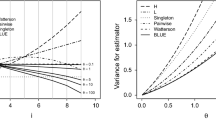Abstract
A method of geographic mapping of the stationary (limiting) gene migration rate has been developed. The method is based on approximation of the empirical distribution of gene frequencies by a theoretical steady-state distribution. The maximum likelihood method and the χ2 minimization method are used to obtain consistent estimations of the gene migration rate as a parameter of the steady-state distribution. The new method makes it possible to determine the geographical distribution of the ratio between the properties of the population migration structure described by the stepping-stone and island models and to construct a geographical map of χ2 values. This map approximately reflects the distribution of natural selection pressure on the gene pool if genetic processes are quasisteady.
Similar content being viewed by others
REFERENCES
Evsyukov, A.N., Zhukova, O.V., Papkov, V.E., et al., Geography of Genetic Processes in Human Populations: Genetic Migrations in the European Region of Northern Eurasia, Genetika (Moscow), 1997, vol. 33, no. 11, pp. 1525-1536.
Evsyukov, A.N., Zhukova, O.V., and Rychkov, Yu.G., Geography of Genetic Processes in Human Populations: Genetic Migrations in the Central Asian Region of Northern Eurasia, Genetika (Moscow), 1999, vol. 35, no. 1, pp. 83-94.
Evsyukov, A.N., Zhukova, O.V., Rychkov, Yu.G., and Sheremet'eva, V.A., Geography of Genetic Processes in Human Populations: Genetic Migrations in Siberia and the Russian Far East, Genetika (Moscow), 2000, vol. 36, no. 2, pp. 271-282.
Wright, S., Isolation by Distance, Genetics, 1943, vol. 28, pp. 114-138.
Wright, S., The Genetic Structure of Populations, Ann. Eugen., 1951, vol. 15, pp. 323-354.
Fotheringham, A., Stewart Charlton, E., and Brunsdon, C., Two Techniques for Exploring Spatial Nonstationarity in Geographical Data, Geogr. Syst., 1997, no. 4, pp. 59-82.
Rychkov, Yu.G. and Balanovskaya, E.V., The Gene Pool and Gene Geography of the USSR Population, Genetika (Moscow), 1992, vol. 28, no. 1, pp. 52-75.
Evsyukov, A.N., Zhukova, O.V., Sheremet'eva, V.A., et al., Geography of the Effective Size of Rural Populations in Northern Eurasia: I. The Effective Size and the Intensity of Random Genetic Drift, Genetika (Moscow), 1996, vol. 32, no. 10, pp. 1396-1405.
Balanovskaya, E.V. and Nurbaev, S.D., Computer Technology of Gene Geographic Studies on the Gene Pool. III. Identification of Trend Surfaces, Genetika (Moscow), 1995, vol. 31, no. 4, pp. 536-559.
Li, C.C., First Course in Population Genetics, Pacific Grove, California: Boxwood, 1976.
Kendall, M. and Stewart, A., Statisticheskie vyvody i svyazi (Statistical Conclusions and Associations), Moscow: Nauka, 1973.
Rychkov, Yu.G. and Sheremetyeva, V.A., The Genetic Process in the System of Ancient Human Isolates in North Asia, in Population Structure and Human Variation, Intern. Biol. Program., Cambridge: Cambridge Univ. Press, 1977, vol. 2.
Kimura, M. and Weiss, G., The Stepping Stone Model of Population Structure and the Decrease of Genetic Correlation with Distance, Genetics, 1964, vol. 49, pp. 561-576.
Weiss, G. and Kimura, M., A Mathematical Analysis of the Stepping Stone Model of Genetic Correlation, J. Appl. Probl., 1965, vol. 2, pp. 129-149.
Evsyukov, A.N., Zhukova, O.V., and Rychkov, Yu.G., Estimation of Population Density and Its Gene Geographical Importance, Genetika (Moscow), 1999, vol. 35, no. 5, pp. 703-711.
Rychkov, Yu.G., Regularities at Serological Differentiation of Siberian Ethnoses, Vopr. Antropol., 1965, no. 21, pp. 18-33.
Berlyant, A.M., Maps of Background and Residual Surfaces and Their Application in Geographical Studies, Vestn. Mosk. Univ., 1969, no. 4, pp. 80-89.
Rychkov, Yu.G. and Balanovskaya, E.V., Ethnical Genetics: Relationships between Adaptive and Neutral Genetic Differentiation of Ethnoses, Genetika (Moscow), 1990, vol. 26, no. 3, pp. 541-549.
Serbenyuk, S.N., Koshel', S.M., and Musin, O.R., Methods for Modeling Geographical Regions from Data Obtained at Nonuniformly Distributed Points, Geodez. Kartograf., 1990, no. 11, pp. 31-35.
Author information
Authors and Affiliations
Rights and permissions
About this article
Cite this article
Evsyukov, A.N., Zhukova, O.V. Estimation of the Stationary Gene Migration Rate: A Cartographic Approach. Russian Journal of Genetics 37, 195–201 (2001). https://doi.org/10.1023/A:1009054224911
Issue Date:
DOI: https://doi.org/10.1023/A:1009054224911




